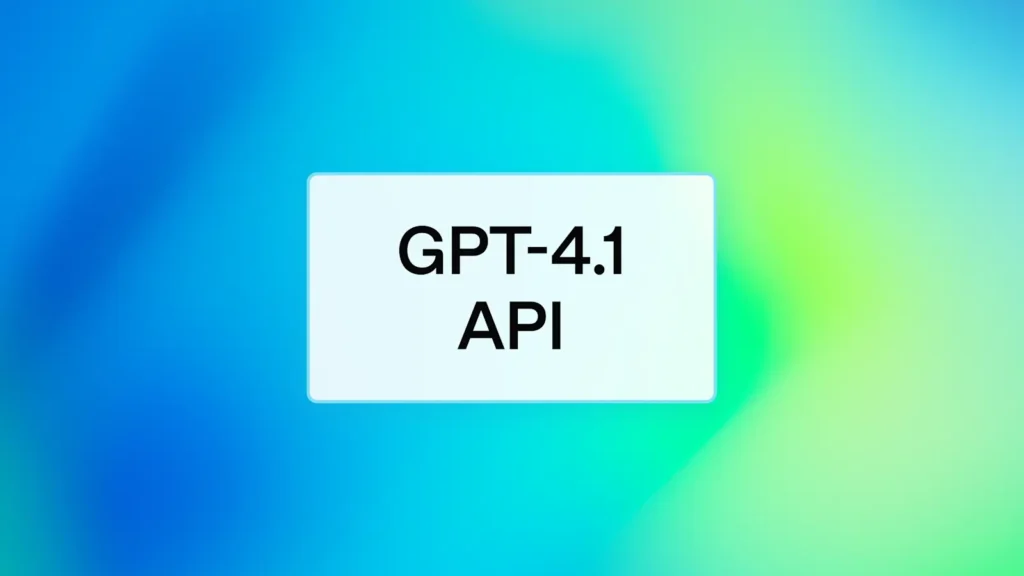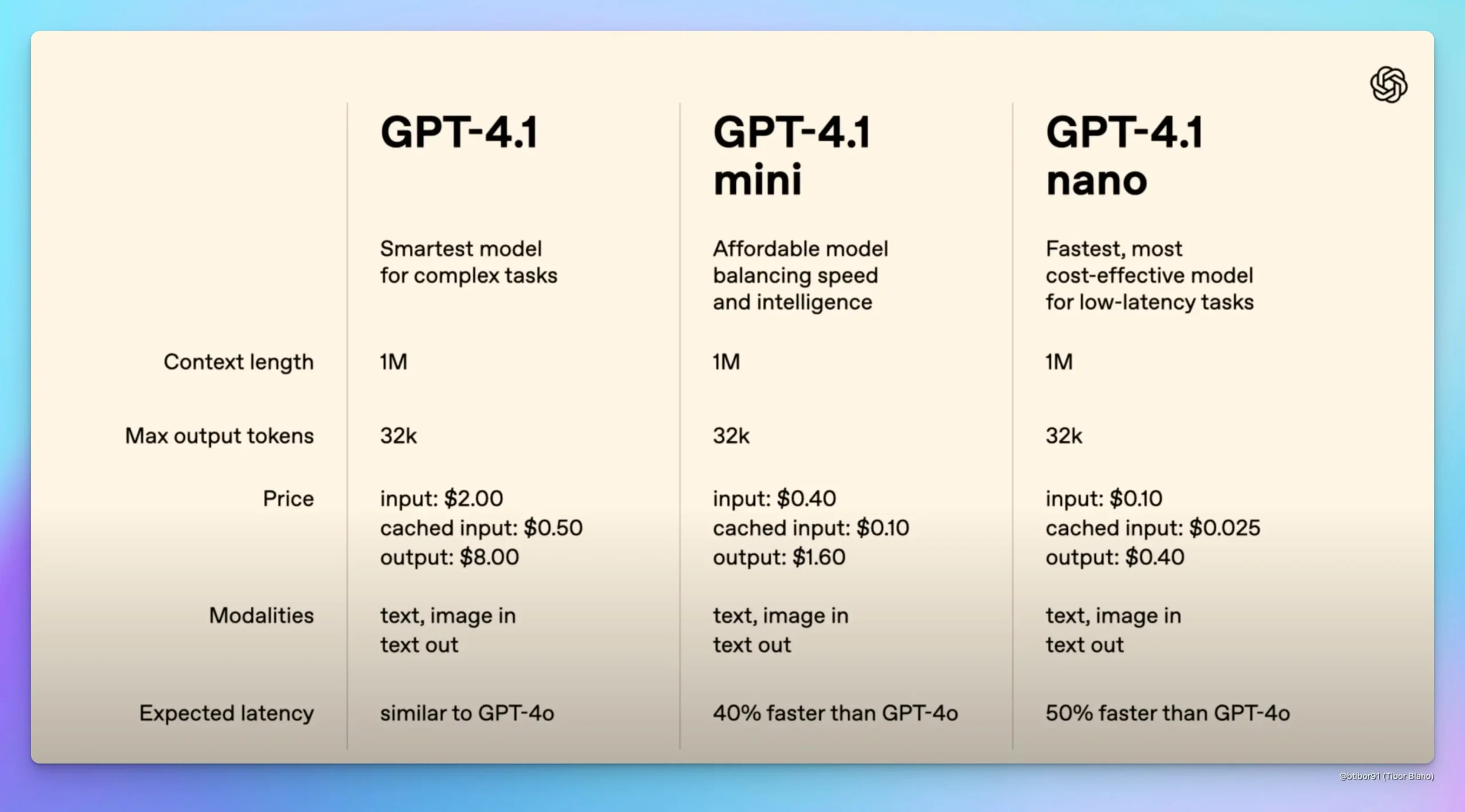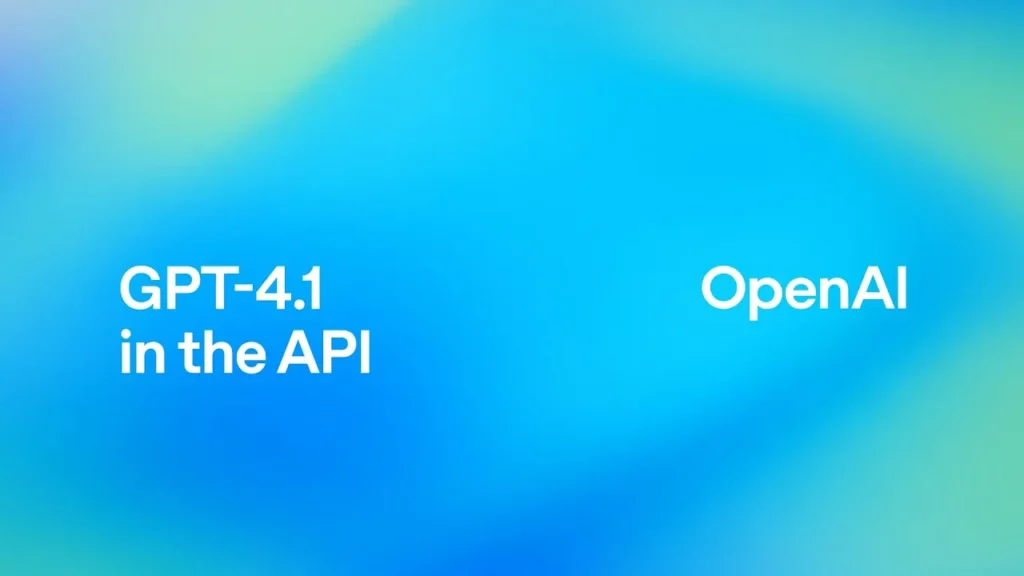GPT-4.1: What Is It & How Can You Use It?
On April 14, 2025, OpenAI unveiled GPT-4.1, its most advanced language model to date, marking a significant milestone in artificial intelligence development. This release introduces three new models—GPT-4.1, GPT-4.1 Mini, and GPT-4.1 Nano—each designed to enhance coding capabilities, instruction following, and long-context comprehension. Notably, GPT-4.1 boasts a 1 million token context window, a substantial increase from previous models. GPT-4.1 is set to reshape how we interact with technology, making complex tasks more manageable.

What Is GPT-4.1 and Why Does It Matter?
A Developer-Centric Evolution
GPT-4.1 is an API-exclusive model, tailored specifically for developers. Unlike its predecessors, it is not integrated into ChatGPT, emphasizing its role in powering sophisticated AI applications. OpenAI’s Chief Product Officer, Kevin Weil, highlighted that GPT-4.1 surpasses GPT-4o in nearly every aspect, offering superior performance in coding tasks and instruction adherence.
Key Enhancements
- Expanded Context Window: GPT-4.1 can process up to 1 million tokens, enabling it to handle extensive documents and datasets.
- Improved Coding Performance: The model demonstrates a 21% improvement over GPT-4o and a 27% enhancement compared to GPT-4.5 in coding tasks.
- Cost Efficiency: GPT-4.1 operates at a lower cost, being 26% cheaper than GPT-4o, making it a cost-effective solution for developers.
A Developer-Centric Evolution
Moreover, GPT-4.1 enhances user engagement through personalized interactions, allowing applications to adapt to user needs in real-time.
GPT 4.1 is an API-exclusive model, tailored specifically for developers. Unlike its predecessors, it is not integrated into ChatGPT, emphasizing its role in powering sophisticated AI applications. OpenAI’s Chief Product Officer, Kevin Weil, highlighted that GPT 4.1 surpasses GPT-4o in nearly every aspect, offering superior performance in coding tasks and instruction adherence.
Key Enhancements
- Expanded Context Window: GPT-4.1 can process up to 1 million tokens, enabling it to handle extensive documents and datasets.
- Improved Coding Performance: The model demonstrates a 21% improvement over GPT-4o and a 27% enhancement compared to GPT-4.5 in coding tasks.
- Cost Efficiency: GPT-4.1 operates at a lower cost, being 26% cheaper than GPT-4o, making it a cost-effective solution for developers.
Each variant of GPT-4.1 addresses specific needs, with GPT-4.1 Mini focusing on general tasks and GPT-4.1 Nano targeting cost-sensitive applications.
Variants for Different Needs:
- GPT-4.1 Mini: A cost-effective version with reduced computational requirements, suitable for applications with limited resources.
- GPT-4.1 Nano: The most lightweight and affordable model, designed for high-speed performance in resource-constrained environments.

The benchmark performance of GPT-4.1 highlights its superiority, making it the go-to choice for developers in need of advanced coding solutions.
How Does GPT-4.1 Compare to Previous Models?
With GPT-4.1, users can expect not only improved instruction adherence but also a more intuitive interaction with AI systems.
Benchmark Performance
GPT-4.1: In terms of encoding ability, GPT-4.1 scored 54.6% in the SWE-bench Verified test, an increase of 21.4 percentage points compared to GPT-4o, and is currently the leading encoding model. In terms of instruction following, its score in Scale’s MultiChallenge benchmark was 10.5 percentage points higher than GPT-4o. In terms of long text understanding, the Video-MME test showed that GPT-41 scored 72.0% in the long video without subtitles category, an increase of 6.7 percentage points over GPT-4o.
GPT-4.1mini: Significant progress has been made in the performance of small models, even surpassing GPT-40 in many benchmarks. It is comparable to GPT-40 in intelligent evaluation, while reducing latency by nearly half and cost by 83%.
GPT-4.1nano: It is the first nano model launched by OpenAl and is currently the fastest and cheapest model. Scored 80.1% on MMLU, 50.3% on GPQA and 9.8% on Aider polyglot encoding, surpassing GPT-4omini.
Instruction Following
By utilizing GPT-4.1, developers can streamline their API integrations, enhancing overall application performance.
With GPT-4.1, users can expect not only improved instruction adherence but also a more intuitive interaction with AI systems.
In summary, using GPT-4.1 provides a competitive edge in software development, enabling faster and more efficient project completions.
GPT-4.1 exhibits a higher degree of reliability in following complex instructions, reducing the need for repeated prompts and enhancing user experience.
Related topics OpenAI Launches GPT-4.1 Series: Pioneering AI Advancements
How to Access GPT-4.1
By utilizing GPT-4.1, developers can streamline their API integrations, enhancing overall application performance.
API Access
In summary, using GPT-4.1 provides a competitive edge in software development, enabling faster and more efficient project completions.
The model is accessible exclusively through OpenAI’s API. Developers can utilize the model by signing up for an OpenAI API account and integrating it into their applications. The API provides access to GPT-4.1 and its variants, allowing for seamless integration into various platforms.

How Can You Use GPT-4.1?
1. OpenAI API
Setup:
Sign up at OpenAI.
Obtain your API key.
Install the OpenAI SDK:
pip install openaiSample Python Code:
import openai
openai.api_key = "your_api_key_here"
response = openai.ChatCompletion.create( model="gpt-4.1", messages=[{"role": "user", "content": "Hello, GPT-4.1!"}] )
print(response.choices[0].message.content)Testing Tools: Use platforms for streamlined API testing and management.
2. OpenAI Playground
- Access GPT-4.1 directly via the .
- Select your preferred model (GPT-4.1, GPT-4.1 Mini, or GPT-4.1 Nano) from the dropdown menu.
3. GitHub Copilot Chat
- Enable GPT-4.1 in GitHub Copilot Chat within Visual Studio Code or Visual Studio 2022.
- For individual users, access is granted upon first use.
- Organizations can manage access through Copilot Business settings.
4. Cursor IDE
- Activate GPT-4.1 in Cursor by navigating to
Settings → Models. - Currently, it’s available for free to allow users to explore its capabilities.
5.CometAPI Access
CometAPI provides access to over 500 AI models, including open-source and specialized multimodal models for chat, images, code, and more. With it, access to leading AI tools like Claude, OpenAI, Deepseek, and Gemini is available through a single, unified subscription.You can use the API in CometAPI to create music and artwork, generate videos, and build your own workflows.
- Log in to cometapi.com. If you are not our user yet, please register first
- Get the access credential API key of the interface. Click “Add Token” at the API token in the personal center, get the token key: sk-xxxxx and submit.
- Select the “
gpt-4.1” endpoint to send the API request and set the request body. The request method and request body are obtained from our website API doc. Our website also provides Apifox test for your convenience. - Replace <YOUR_AIMLAPI_KEY> with your actual CometAPI key from your account.
See Also GPT-4.1 API ,GPT-4.1 Nano API and GPT-4.1 Mini API for integration details.
✍️ Prompting Best Practices
- Provide Clear Instructions :Be specific and explicit in your prompts to guide the model effectivel.
- Use Contextual Examples :Including examples can help the model understand the desired output forma.
- Induce Planning :Encourage the model to plan its responses for complex task.
- Adapt Prompts :Given GPT-4.1’s literal interpretation, ensure your prompts are precise to avoid misinterpretatio
Practical Applications of GPT-4.1
Software Development
GPT-4.1’s enhanced coding capabilities make it an invaluable tool for developers, assisting in code generation, debugging, and understanding complex codebases. Its ability to process extensive code repositories streamlines the development process.
Data Analysis
The model’s expanded context window allows for the analysis of large datasets, facilitating insights and decision-making in data-driven fields.
Educational Tools
The model can power educational applications, providing detailed explanations and tutoring in various subjects, adapting to individual learning styles.
Future Outlook
OpenAI’s release of GPT-4.1 signifies a shift towards more specialized and efficient AI models. With plans to discontinue GPT-4.5 by July 2025, GPT-4.1 is poised to become the standard for developers seeking advanced AI capabilities.
Conclusion
GPT-4.1 represents a significant advancement in AI, offering developers a powerful tool for a wide range of applications. Its improved performance, cost efficiency, and specialized variants make it a versatile choice for integrating AI into modern software solutions.


